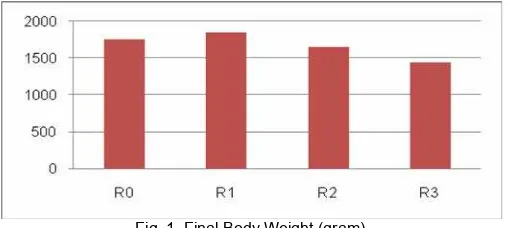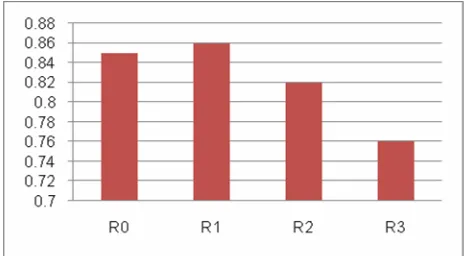UTILIZING WASTE PRODUCT OF TUNA (
Thunnus atlanticus)
FISH SILAGE AND ITS IMPLEMENTATION
ON THE MEAT PROTEIN CONVERSION OF BROILER
Tuti Widjastuti, Hendronoto Arnoldus A.W Lengkey,
R. Wiradimadja, D. Herianti
Faculty of Animal Husbandry, Padjadjaran University, Bandung-Indonesia e-mail : [email protected]
Abstract
The research was held to find out the effect and optimal of adding waste product of Tuna (Thunnus atlanticus) fish silage in ration on the meat protein conversion of broiler. The research used 100 broiler day old chicken, were devided into twenty cages, and each unit cage consists of five broiler chickens. The research was conducted with experimental method of Completely Randomized Design with four treatments, where each treatment was repeated five times and each repeated consist of five broiler chicks. The treatmens consist of one ration without waste of Tuna fish silage (R0), and each
level of ration contains waste of Tuna fish silage R1 (4%), R2 (6%) and R3 (8%). Variable analysis
were final body weight, carcass percentage and the meat protein conversion of broiler. Conclusion of research showed that by using waste of Tuna fish silage until 4 percent level in ration had optimal
response on the final body weight (R1=1844.87 gram, R0= 1755.03 gram, R2 = 1654.84 gram,
R3= 1439.53 gram), carcass percentage (R1=72.63%, R0=69.20%, R2= 67.85%, R3= 65.90%) and the
meat protein conversion of broiler (R1=0.86, R0 = 0.85,R2= 0.82, R3=0.78 ).
Key words: Tuna fish, silage waste, final body weight, carcass percentage, meat protein conversion
INTRODUCTION
Rations are environmental factors that can affect the success of the poultry business, due to production costs incurred 60-70 percent. Increased production costs can be overcome by finding a quality alternative feed ingredients. One alternative feed ingredients that have good potential as a substitute for fish meal is the waste of processed tuna industry, which consists of head, viscera, flesh and bone whose numbers may reach 10-25% of the total catch and harvest fish, estimated at about 500,000 tons per year, can be utilized as a component of animal feed [8]. Waste product of fish if given directly to cause negative effects because the waste can be easily damaged and rotten, so need to be processed first, namely through the process of making silage.
Processing of silage did not cause environmental pollution because no part of fish is wasted. Processing of fish silage by using organic acids can work with higher pH, ie pH 4 and finaly product can be given directly to livestock, while the mineral acid
must be neutralized first [11]. Addition of acid will accelerate the dissolution of fish, while it also inhibits spoilage by bacteria or fungi. On manufacturly chemical silage, prior to the addition of acid, the pH of the fish was 6.8 and after addition of acid will drop to 3.2 and kept in a low pH for 5 days, then the pH will rise and eventually stink after the mushrooms growth [6],[12]. Enzymes contained in fish helped solve the peptide chains that are not solved by the acid. Composition of nutrients in fish silage is similar to fish meal fish. Silage made from whole fish water contained water 70-75%, protein 18-20%, fat 1 -2% and ash about 4-6% [11].
tryptopan, and problems in storage and transportation because in liquid form and the volume is large enough. However, this can be overcome by drying the silage dry when way mixed with other feedstuffs such as corn or rice bran. Tuna fish silage consisting of the head and the remaining of flesh and bone, is made by adding 3% formic acid (90%) and propionate acid (99%) with ratio 1:1. Tuna waste has 20.17% crude protein, 1.17% crude fat, 1.01% crude fiber, 74.11% water and metabolizable energy 1002 kcal/kg. The
water content of tuna silage (Thunnus
atlanticus) is 63.75%, 34.97% crude protein, crude fat 0.55% and 2067.85 kcal/kg of metabolic energy [2]. While fish meal content of 63.05% crude protein, 0.89% crude fiber, 4.34% calcium, 2.80% phosphorus and 2853.20 kcal/kg metabolizable energy [3].
The carcass are consumed us fillet or whole carcass, and the carcass was related to weight gain. Carcass production associated with weight gain. Bone as part carcass whose condition will affect the meat, where the longer bones will produce more meat. Percentage of carcass components of broiler male were 58.60 % meat, 24.26% bone and 14.87% skin and the female were 61.14% meat, 22.17% bone, and 14.10% [12]
Tuna fish silage as good protein supplement can partially replace the fish meal in broiler ration [7]. The fish silage in broiler ration is recommended only up to
level 5% - 7% level [7] but more this 8% tuna silage have negative effect to growth broiler [10]. The aim of this experiment are to study the optimal percentage tuna fish silage in broiler ration that will raised the final body weight, the carcass percentage and meat protein conversion of broiler.
MATERIALS AND METHOD
The research used 100 day old chick broiler, with average body weight 45.66 gram and coefficient variable 4.59%. The birds kept in litter system, as much as 20 flock, and each unit consist 5 chickens. Every flock is equipped with round feeder and waterer, and 60 watts hanging, bulb lamp as heater at the middle of each flock.
The ration consist of corn-meal, fish- meal,rice bran-meal, soy-bean meal, coconut meal, tuna fish silage, CaC03 and premix additive are 23% protein and 3200 Kcal/kg of metabolizable energy. Fish silage made chemically by adding 3% formic acid (90%) and propionic acid in the ratio 1: 1 on the fish waste. The formula rations were :
R0 Control diets
R1 Diets contain 4% of tuna fish silage
and 11% of fish meal
R2 Diets contain 6% of tuna fish silage
and 7% of fish meal
R3 Diets contain 8% tuna fish silage and 3% of fish meal
Table 1. Ration Composition (%)
Ingredients Diets
R0 R1 R2 R3
Yellou corn 57.50 60.00 59.50 60.00
Soybean meal 19.75 16.50 17.25 18.25
Coconut meal 3.00 3.75 2.75 3.00
Total 100.00 100.00 100.00 100.00
Notes : R0 = Control diets, R1 = Diets contain 4% tuna silage, R2 = Diets contain 6% tuna silage,
R3 = Diets contain 8% tuna silage
The compositions of the rations and the metabolizable energy and nutrient content in Table 1 and Table 2 consecutively. Completely
Randomized Design (CRD) wasused in this
was analyzed by random simple test, and
among treatments with Duncan,s Multiple
Range Test. Variable analysis were final body
weight, carcass percentage and the conversion of meat protein.
Table 2. The Nutrient and metabolizable energy content (%)
The nutrients R0 R1 R2 R3
Crude Protein 23.03 23.27 23.04 23.01
Crude Fat 7.84 7.38 7.45 7.45
Crude Fiber 5.38 7.95 8.06 8.20
Calsium 1.19 1.09 0.99 0.80
Phosphor 0.98 0.87 0.81 0.73
Metabolizable energy (Kcal/kg) 3281.56 3254.81 3232.74 3214.25
RESULTS AND DISCUSSION
The final body weight, carcass percentage and conversion of meat protein is showed in Table 3.
Table 3. Average of Final Body Weight, Carcass Percentage and Meat Protein Conversion
Variables R0 R1 R2 R3
Final body weight (g) 1755.03ab 1844.87 b 1654.84a 1439.53a
Carcass (%) 69.20ab 72.63 b 67.85 a 65.90 a
Meat-protein conversion (index) 0.85 b 0.86 b 0.82 b 0.78 a Note: The same letter on the same line show no significant difference (P<0.05)
Final Body Weight
Diets contain of 4% of tuna fish silage and 11% of fish meal (R1) gave the best result on final body weight, and significantly different (P<0.05) from other treatments, but has no significant effect to feed consumption. which was not significant. R1 ration and R0
(control) was better than R2 and R3, because
it contains complete amino acids. In R3, the
amino acids was inbalance, so give the lowest final body weight.
The final body weight of broiler that feed with tuna fish silage is lower than fish meal, ever the processing didn’t destroy the nutritional quality of the row materials [6], [12].
Fig. 1 Final Body Weight (gram)
Carcass Percentage
Broiler carcass weight was determine after eviceration. The carcass weight percentage often used as meat production measurement, in this research (67.50 to 66.67%) were in the
Fig. 2 Carcass Percentage (%)
Analysis of variance showed (Table 3) that silage tuna fish has significancy (P<0.05) to carcass percentage. By giving 4% tuna fish silage in the diets gave the optimal affect on carcass percentage, because by giving 6% and 8% will decreased the carcass percentage. Acording [9] that influence carcass weight in addition to the nutrients in the diets.
Meat–Protein Conversion
The average of meat-protein conversion is showed in Table 3. The meat protein
conversion in R3 is lowest (0.76) and those R1 was highest (0.86). Analysis of variance showed that tuna fish silage that added until 6% into the diets has significancy (P<0.05) to meat protein conversion. Because the content of amino acids in tuna fish waste silage well enough tuna fish silage to partially replace fish meal in the diets without affecting the conversion of broiler meat protein.
Fig.3. Meat- Protein Conversion
The digestibility of fish silage is higher and the amino acids that are available are better than fish meal [4]. Utilization of fish silage protein of almost 100%, whereas the fish meal only between 30 - 60%. Giving waste product of fish silage in broiler diets is recommended only up to level 5% - 7% [7].
CONCLUSIONS
1. Until 6% tuna fish silage have no significant effects on final body weight, carcass percentage and meat protein conversion.
2. R1 diet (4% tuna fish silage) has the
REFERENCES
[1] Cononizado, S.O. By products technology and
waste utilization. Proc. I.P.F.C. (1989) 18(3):507.
[2] Departemen Kesehatan Republik Indonesia. Kandungan Zat makanan Silase Ikan Tuna (Thunnus atlanticus). 2001.
[3] Faculty of Animal Husbandry, Padjadjaran University.Bandung Jawa Barat. Proximat Analysis of Waste Product Tuna Fish Silage. 2001. [4] Gohl,B. Tropical Feed. F.A.O. Rome. 1975. [5] Hayse, P.L. and Willian, W.M. Eviceraped yield component parts and meat skin and bone rations in the chicken broiler. Poul Scie. (1973) 52 :718-722.
[6] Kompiang, I.P. dan Creswell, D. Fish silage in diets for broiler chicken. First Asian Australian Animal Congress. Malaysia. (1980).
[7] Kompiang. Pengaruh silase ikan sebagai pengganti tepung ikan terhadap produksi telur dan
produksi daging pada ayam. In Proc. Ilmu dan Peternakan. BPT Bogor, 1983. Vol 1:2
[8] Kompiang I.P. and Ilyas. Silase ikan, pengolahan, penggunaan dan prospeknya di Indonesia. J. Litbang Pertanian (1993)11 : 1. [9] Morran, E.T. and H.L.Orr. Influence of strain on the yield of commercial parts from the chicken broiler carcass. Poul Scie (1970) 49:725.
[10] Ratagool, P.P., N. Wong and Swachatthamwongratana, S. Studies on the nutritive value of fish silage for broiler chicken. In Proc. I.P.F.C Workshop Fish Silage. FAO. Rep. 1980, No.230.
[11] Victor Simamora. Ekstrasi Lemak Ikan Silase Kimia dan Kestabilan Proteinnya, Akademi Kimia Analisis, Bogor.1981.


